Huffman's Greedy Algorithm
Core Idea of Huffman’s Algorithm
At its heart, Huffman’s algorithm is a greedy, bottom-up construction of an optimal prefix-free code. Here’s the intuition:
- Symbols as Weighted Leaves
- Begin by treating each symbol $\sigma_i$ as a leaf node in a forest (a collection of one-node trees), labeled with its frequency $p_i$.
- Greedy Merge of the Least-Frequent
- Always pick the two trees with the smallest total frequencies.
- Merge them under a new parent node whose frequency is the sum of those two.
- Repeat the $`` \text{extract two smallest } \rightarrow \text{ merge } \rightarrow \text{ reinsert}’’$ step until only one tree remains.
- Interpret the Tree as Codewords
- Label each left‐edge $`` 0’’$ and each right‐edge $`` 1’’$.
- The codeword for a symbol is simply the sequence of $0$’s and $1$’s along the path from the root to its leaf.
Why This Builds an Optimal Code
Local Optimality → Global Optimality
By always merging the two least-likely symbols, Huffman’s greedy step mimics the structure any optimal code must have: the two rarest symbols are siblings at maximum depth.
Optimal Substructure
Once you merge two symbols, you’ve reduced the problem size by one — creating a new “super-symbol” whose frequency is the sum of its parts. Solving this smaller problem optimally and then unpacking the merges yields a globally optimal tree.
Visualization
Suppose we have the symbols:
$$ \lbrace A,B,C,D,E\rbrace $$
and frequencies
$$ A:45,~ B:13,~ C:12,~ D:16,~ E:9 $$
Step #1: Start with five one-node trees
Each symbol is its own tree, weighted by its frequency.

Step #2: Find the two smallest frequencies
The smallest are $E(9)$ and $C(12)$. Merge them into a new subtree whose frequency is $9+12=21$.
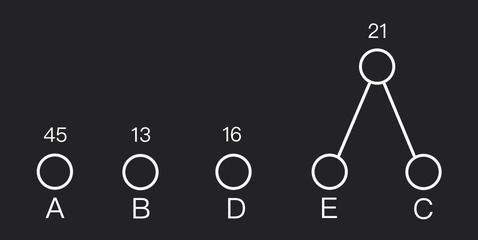
Step #3: Again pick the two smallest
Now the forest has frequencies $13, 16, 21, 45$. The two smallest are $B(13)$ and $D(16)$. Merge into one node with frequency $13+16=29$.
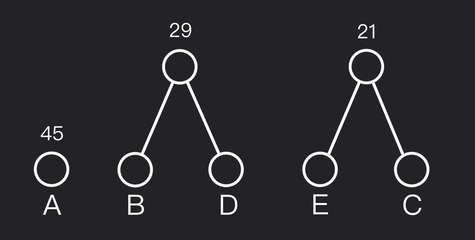
Step #4: Merge the next two smallest
Forest frequencies are now $21, 29, 45$. Merge two trees with frequencies $21$ and $29$ into one node with frequency $21+29=50$.
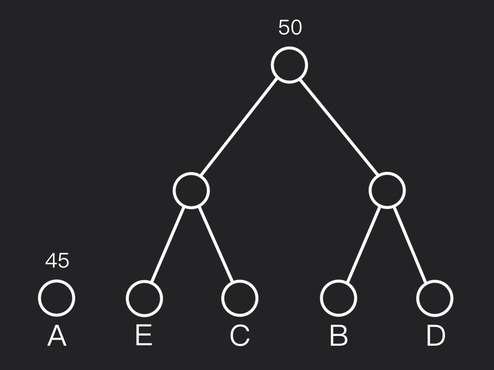
Step #5: Final merge to form the full tree
Only two trees remain. Merge into the root, frequency $45+50=95$. This completes the Huffman tree.
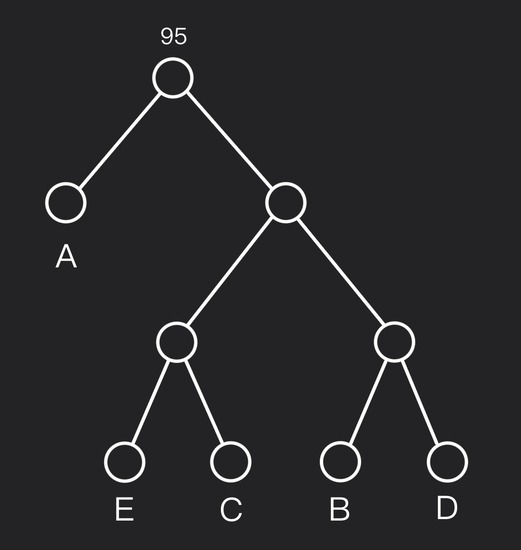
Reading Off the Codewords
So the final Huffman tree is:
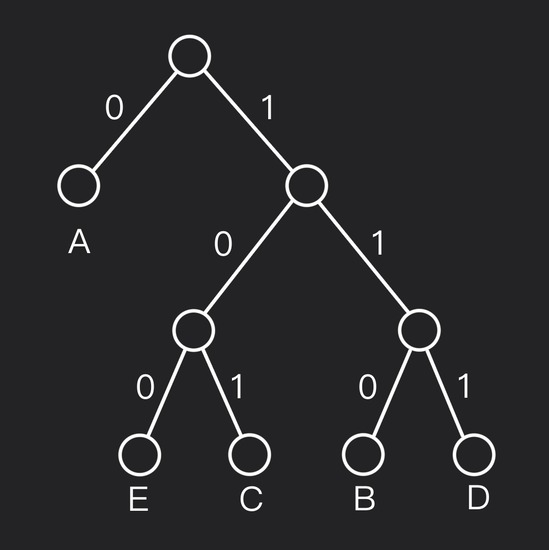
Follow the path from root to each leaf, writing down the bits:
- $A: ~ \text{left} \implies \text{code: 0}$
- $B: ~ \text{right} \rightarrow \text{right} \rightarrow \text{left} \implies \text{code: 110}$
- $C: ~ \text{right} \rightarrow \text{left} \rightarrow \text{right} \implies \text{code: 101}$
- $D: ~ \text{right} \rightarrow \text{right} \rightarrow \text{right} \implies \text{code: 111}$
- $E: ~ \text{right} \rightarrow \text{left} \rightarrow \text{left} \implies \text{code: 100}$
Average Code Length
$$ L_{avg} = \sum_{\sigma \in \lbrace A,B,C,D,E \rbrace} p_\sigma \cdot l_\sigma \cdot \frac{45 \cdot 1 + 13 \cdot 3 + 12 \cdot 3 + 16 \cdot 3 + 9 \cdot 3}{95} \approx 2.05 ~ \text{bits/symbol} $$
This is the minimum possible average length for any prefix-free code on these frequencies.
Last updated 09 May 2025, 23:43 +0500 .